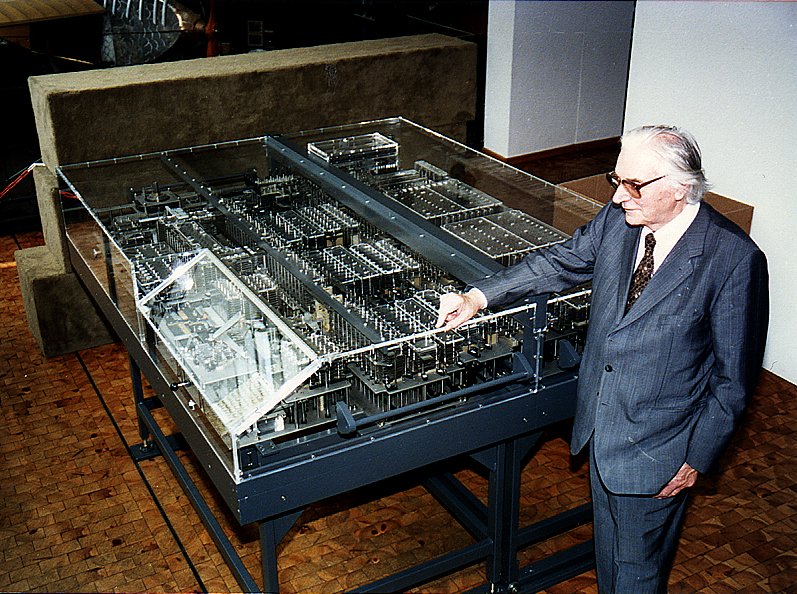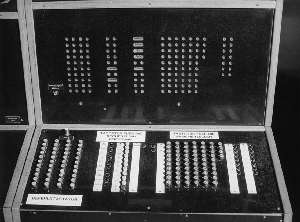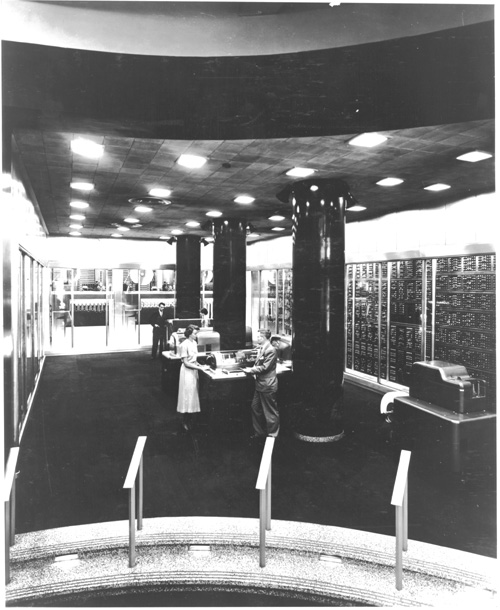U n i v e r s i t é Y O R K U n i v e r s i t y
ATKINSON FACULTY OF LIBERAL AND PROFESSIONAL STUDIES
SCHOOL OF ANALYTIC STUDIES & INFORMATION TECHNOLOGY
S C I E N C E A N D T E C H N O L O G Y S T U D I E S
STS 3700B 6.0 HISTORY OF COMPUTING AND INFORMATION TECHNOLOGY
ATKINSON FACULTY OF LIBERAL AND PROFESSIONAL STUDIES
SCHOOL OF ANALYTIC STUDIES & INFORMATION TECHNOLOGY
S C I E N C E A N D T E C H N O L O G Y S T U D I E S
STS 3700B 6.0 HISTORY OF COMPUTING AND INFORMATION TECHNOLOGY
Lecture 17: The Great Electromechanical Computers
| Prev | Next | Search | Syllabus | Selected References | Home |
| 0 | 1 | 2 | 3 | 4 | 5 | 6 | 7 | 8 | 9 | 10 | 11 | 12 | 13 | 14 | 15 | 16 | 17 | 18 | 19 | 20 | 21 | 22 |
Topics
-
"Man-computer symbiosis is an expected development in cooperative interaction between men and electronic computers. It will involve very close coupling between the human and the electronic members of the partnership. The main aims are 1) to let computers facilitate formulative thinking as they now facilitate the solution of formulated problems, and 2) to enable men and computers to cooperate in making decisions and controlling complex situations without inflexible dependence on predetermined programs. In the anticipated symbiotic partnership, men will set the goals, formulate the hypotheses, determine the criteria, and perform the evaluations. Computing machines will do the routinizable work that must be done to prepare the way for insights and decisions in technical and scientific thinking. Preliminary analyses indicate that the symbiotic partnership will perform intellectual operations much more effectively than man alone can perform them… As a concept, man-computer symbiosis is different in an important way from what North has called 'mechanically extended man.' In the man-machine systems of the past, the human operator supplied the initiative, the direction, the integration, and the criterion. The mechanical parts of the systems were mere extensions, first of the human arm, then of the human eye. These systems certainly did not consist of 'dissimilar organisms living together… ' There was only one kind of organism—man—and the rest was there only to help him."
J C R Licklider - In his History of Computing Technology, Michael Williams distinguishes between what he calls the Mechanical Monsters and the Electronic Revolution. The first category includes the Zuse machines as well as the Bell Relay Computers which evolved from Stibitz's Model-K, the Harvard Mark I through IV, the IBM Calculators such as the 601/602, and the SSEC or Selective Sequence Electronic Calculator. These are machines were constructed essentially using "mechanical, electromechanical, or relay technology." As Williams points out (op. cit., p. 209), "The intial designs of some of the entirely electronic machines were influenced to a considerable degree by those mechanical giants and, although they left no direct descendants in the computing field, they were vital as stepping stones toward the electronic stored program computer." Williams' second category includes of course the ENIAC, as well as the Colossus and the Heath Robinson, the EDVAC, the Manchester Machine and its subsequent variations, the EDSAC, the UNIVAC, etc. It would be impossible, in the present context, to review all these machines in any detail. I will therefore focus essentially on the Zuse machines, in the first category, and on the ENIAC in the second.
-
Konrad Zuse (1910 - 1995). This reference includes also an
autobiographical essay by Zuse himself, "My First Computer and First Thoughts About Data Processing."
A very interesting source of information is The Life and Work of Konrad Zuse, written
by Horst Zuse, the eldest son of Konrad Zuse. MacTutor also has a webpage dedicated to Konrad Zuse.
Finally, you can visit Konrad Zuse and His Computers, a multimedia show,
where you will find photographs, schematics and data sheets of Zuse's machine.

The Rebuilt Z1 in the Deutsche Technik Museum Berlin (1989)
For various reasons, not last of which was the fact that it was a time of war and that the Nazi government failed to realize the military importance of computers, Zuse worked by himself, essentially isolated from any other group."I started in 1934, working independently and without knowledge of other developments going on around me. In fact, I hadn't even heard of Charles Babbage when I embarked on my work. At that time, the computing industry was limited to mechanical calculators using the decimal system. Punched card devices were slightly further developed and able to deal with relatively complex operations for statistical and accounting purposes. However, these machines were almost entirely designed for commercial application. This meant that mathematicians and engineers had to develop computers on their own, working independently from one another. I was no exception… My research was initially aimed at pure number calculation, but soon led on (1935/36) to new ideas about 'computing' in general. Personally, I believe that was the birth of modern computer science. I recognized that computing could be seen as a general means of dealing with data and that all data could be represented through bit patterns, generally speaking."
Here are the milestones in Zuse's work:- Z1 (1938), a mechanical programmable digital computer. Although mechanical problems made its operation erratic, it was rebuild by Zuse himself after the war.
- Z2 (1940), an electro-mechanical computer.
- Z3 (1941), this machine uses program control.
- Z4 (1942), thanks also to the Planfertigungsgerät, "it was possible to use symbolic memory cells, instructions and symbolic arithmetic operations for the creation of a program. It also was possible to copy programs and to make corrections." [from Konrad Zuse and His Computers ]
- Plankalkül (1945/46), the first programming language, implemented on the Z3.
- …
- Z22 (1958), the last machine developed by Zuse. It was one of the first to be designed with transistors.

The Z4 Planfertigungsgerät.
-
It is worth noting that Zuse had to discover independently the work of Turing and Shannon:
"I defined 'computing' as 'the formation of new data from input according to a given set of rules.' This basic theory meant that all computing operations could be carried out by relays operating according to the dual status principle just mentioned [ open/close status of relays ] . The most suitable devices available at the time were telephone relays. Now a link with mathematical logic had been forged. As an engineer I had no idea of the existence of such a discipline. I developed a system of 'conditional propositions' for relays—something that corresponded approximately to what is known as Boolean algebra today. My former mathematics teacher showed me that this sort of calculation was identical with the propositional calculus of mathematical logic."
The importance of Zuse's machines is nicely summarized by Williams (op.cit., p. 210):"Konrad Zuse holds a special place in the history of computation because it was he who first managed to construct an automatically controlled calculating machine. It was not electronic, and it did not have a stored program, but it was capable of being automatically controlled by an external reader, which would take the instructions to be executed from a punched tape."
-
Finally, it must also be pointed out that Zuse was among the first to realize the necessity of using floating point arithmetic.
This necessity stems from the fact that most real numbers require an infinite number of digits to be specified, and that
computers can only represent a number using a small number of bits. The difficulty lies in the requirement that
calculations performed on a computer should be consistent with the abstract, general rules of arithmetic, and
minimize the round-off error necessarily introduced by the machine.
"Therefore, all floating point formats that had been in use, in the history of practical numerical computation, had a 3-part format:
- An exponent—so that the range is larger
- A mantissa—so that the set looks dense enough
- A sign bit—so that both positive and negative numbers could be represented
[ from An Informal Description of IEEE754 ] -
Before passing on to the ENIAC, we must mention two other threads in the history of this period. The first
is about the machines that were developed from the original experimental circuit built by George Stiblitz ((1904 - 1995), the K-Model
( see Lecture 16 ). Together with S B Williams, Stiblitz built the
Complex Number Calculator in 1939. This machine "remained in daily use at Bell Labs until 1949" ( Williams, op. cit., p, 223 ).
Stiblitz and the Bell Labs were also involved in the construction of various models of the Relay Calculator,
"an automatic aiming device for antiaircraft guns. The object of this project was to a dvice which, as the gunner turned
knobs to track an airplane across the sky, would automatically aim the gun far enough ahead of the airplane that the
chance of a hit being scored would be improved over manual aiming of the gun." (Williams, op.cit., p. 225). This
project is important, because Stiblitz decided that the best way to test the performance of the system was to use a dedicated
version of the Complex Number Calculator to simulate actual field conditions. An interesting feature of the Model II Relay
Calculator incorporated a self-check system to ensure that the expected failure of some relays would be compensated. The Model II
was soon replaced by a series of more and more reliable and fast machines, the last one being the Model V or The
Twin Machine. This was truly an electromechanical monster: "The Model V was actually two machines in one. It could be split
in half with each half working on a separate problem or, for larger calculations, both halves would work together… Each of
the two Model V machines contained about 9,000 relays and about 50 pieces of miscellaneous teletype equipment; it weighed
in at about 10 toms and required 10,000 sq ft of floor space to accommodate it… The arithmetic unit was interesting
in that it did not really have any arithmetic circuitry; rather it looked up the answer to any addition problem in a large
hardwired addition table… The instructions, rather than being coded as a single row of punches as in the earlier Bell
machines, were actually punched out as a series of letters in the six-hole-wide paper tape. A typical instruction might
have been: BC + GC = A, which would have been interpretated by the Model V as 'add the contents of register
B to the contents of register G and put the result in register A'. The optional 'C' in the instruction meant to clear the
registers to zero when the operation was complete." ( Williams, op. cit., p. 231-2)
The second thread is represented by the so-called Harvard Machines (Mark I through IV), due to Howard Hathaway Aiken
(1900 - 1973) and Grace Murray Hopper (1906 - 1992).

Grace Hopper's Log Page with First 'Computer' Bug
Aiken was a physicist, and was led to computers by the need to solve very complex, non-linear differential equations. He "wrote a report on how he envisaged the machine, and in particular how such a machine designed to be used in scientific research would differ from a punched card machine. He listed four main points:…whereas accounting machines handle only positive numbers, scientific machines must be able to handle negative ones as well; that scientific machines must be able to handle such functions as logarithms, sines, cosines and a whole lot of other functions; the computer would be most useful for scientists if, once it was set in motion, it would work through the problem frequently for numerous numerical values without intervention until the calculation was finished; and that the machine should compute lines instead of columns, which is more in keeping with the sequence of mathematical events."
It is interesting to note that, only after enlisting the help of other, rather more famous scientists, he was able to persuade IBM to build such a machine. Apparently IBM thought this would constitute good advertising for the company. By 1943 the Mark I was delivered to Harvard University. Due to the war, however, the machine was quickly employed for military purposes by the US Navy's Bureau of Ships. Other models were built after the end of the war. The Harvard Machines represented the cutting edge of computer technology, and their design substantially influenced the developemnt of many other machines, such as ENIAC.
[ from MacTutor ] -
The history of the Harvard Machines also includes the creation of the first compiler by Grace Hopper in 1952.
"This revolutionary software facilitated the first automatic programming of computer language. Before Hopper's invention, programmers had to write lengthy instructions in binary code (computer language) for every new piece of software. Because binary code consists solely of 0's and 1's, it was difficult for programmers to get through their time-consuming tasks without many frustrating mistakes. Hopper knew there had to be a solution to this dilemma. Determined, she wrote a new program which freed software developers from having to write repetitive binary code. Each time the computer needed instructions that were common to all programs, the compiler would have the computer refer to codes in its own memory. The compiler was a time and error-saving breakthrough for the computer world, but Hopper didn't stop there. She also invented COBOL, the first user-friendly business software program, which is still in use today."
In 1970 Hopper received the Computer Society's Harry M Goode Memorial Award
[ from Grace Hopper: Computer Compiler ]"For her pioneering work and leadership in the development of computer software, and for her impact and influence on the computing profession and her fellow colleagues, and for her pioneering work and leadership in the development of important concepts for mathematical and business compilers, and for her contributions to the development and acceptance of English-language, problem-oriented programming, and for her outstanding work and continued efforts in the education and training of men and women for careers in computer science and data processing." [ from MacTutor ]
-
Finally, I want to mention IBM's Selective Sequence Electronic Calculator (SSEC), popularly known as Poppa,
which according to Williams (op.cit., p. 255) "was, by a substantial margin, the largest and most complex of the electromechanical.
computers." In some quarters it has been called a publicity stunt,
since it "was placed behind large windows on the ground floor of IBM's main office building in New York." ( Williams, op.cit., p. 255 )
It was used, however, for serious purposes by the Atomic Energy Commission, as well as by various scientists, for example "to
tabulate the positions of the five outer planets over 40 days for the period from 1653 to 2060." ( ibidem, p. 257 ).

IBM's Selective Sequence Electronic Calculator (SSEC)
Readings, Resources and Questions
-
To appreciate more deeply the particular history we are discussing, you may want to look at a more
general timeline
 100 Years of Manufacturing Achievements,
which covers the period 1895 to 1998. Here is also another interesting,
100 Years of Manufacturing Achievements,
which covers the period 1895 to 1998. Here is also another interesting,  Full Timeline.
Full Timeline.
© Copyright Luigi M Bianchi 2001, 2002, 2003
Picture Credits: Konrad-Zuse.de · IEEE Computer Society · Naval Historical Center
Last Modification Date: 11 April 2003
Picture Credits: Konrad-Zuse.de · IEEE Computer Society · Naval Historical Center
Last Modification Date: 11 April 2003